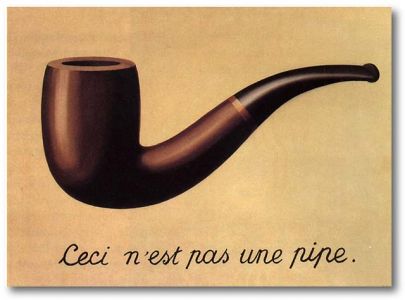Difference between pages "JCM312/French Cinema Between the Wars I: Popular Front (Discussion)" and "JCM312/The Avant-Garde (Discussion)"
From Screenpedia
(Difference between pages)
Jump to navigationJump to search (updated) |
(→External links: updated) |
||
| Line 1: | Line 1: | ||
| − | =='' | + | <gallery mode="packed" heights=200px> |
| − | + | File:TreasonOfImagesShadow.jpg|alt=René Magritte's ''The Treason of Images'' (1928-9).|René Magritte's ''The Treason of Images'' (1928-9). | |
| − | + | </gallery> | |
| − | + | #'''Group 1:''' Why were surrealists obsessed with dreams and the insane? What does Robert Hughes mean when he characterizes "neurosis" as "the permanent involuntary form of dreams"? | |
| − | + | #'''Group 2:''' René Magritte's ''The Treason of Images'' (1928-9) contains the phrase, "Ceci n'est pas une pipe" ("This is not a pipe"). What does Hughes feel is the significance of this phrase? | |
| − | * | + | #'''Group 3:''' How does Hughes characterize the surrealist use of sexuality? |
| + | #'''Group 4:''' What previously dismissed forms of art (what Hughes calls, "kinds of expression") did surrealists advocate for? Why? | ||
| + | #What elements of surrealism do you see in these films? | ||
| + | #*'''Group 1 and 6:''' ''Entr'Acte'' (Clair, 1924) | ||
| + | #*'''Groups 2 and 5:''' ''Un Chien Andalou'' (Buñuel/Dalí, 1928) | ||
| + | #*'''Groups 3 and 4:''' ''Zero for Conduct'' (Vigo, 1933) | ||
| + | #'''All groups:''' Hughes maintains that "The [surrealist] object was collage in three dimensions" (p. 241). What do you think he means by this? (Meret Oppenheim's ''Luncheon in Fur'' is one example.) | ||
| − | == | + | ==Bibliography== |
| − | + | *Hughes, Robert. ''The Shock of the New''. NY: Alfred A. Knopf, 1980. | |
| − | |||
| − | |||
| − | |||
| − | |||
| − | |||
| − | |||
| − | |||
| − | |||
| − | |||
| − | |||
| − | |||
| − | |||
| − | |||
| − | |||
| − | |||
| − | |||
| − | |||
| − | |||
==External links== | ==External links== | ||
| − | *[ | + | *[https://tvcrit.org/Classes/Jbutler/T340/SurrealismLecture.php Dada & Surrealism Illustrations] |
| − | |||
| − | |||
| − | |||
[[Category:JCM312 Discussion]] | [[Category:JCM312 Discussion]] | ||
Revision as of 21:47, 16 September 2019
- Group 1: Why were surrealists obsessed with dreams and the insane? What does Robert Hughes mean when he characterizes "neurosis" as "the permanent involuntary form of dreams"?
- Group 2: René Magritte's The Treason of Images (1928-9) contains the phrase, "Ceci n'est pas une pipe" ("This is not a pipe"). What does Hughes feel is the significance of this phrase?
- Group 3: How does Hughes characterize the surrealist use of sexuality?
- Group 4: What previously dismissed forms of art (what Hughes calls, "kinds of expression") did surrealists advocate for? Why?
- What elements of surrealism do you see in these films?
- Group 1 and 6: Entr'Acte (Clair, 1924)
- Groups 2 and 5: Un Chien Andalou (Buñuel/Dalí, 1928)
- Groups 3 and 4: Zero for Conduct (Vigo, 1933)
- All groups: Hughes maintains that "The [surrealist] object was collage in three dimensions" (p. 241). What do you think he means by this? (Meret Oppenheim's Luncheon in Fur is one example.)
Bibliography
- Hughes, Robert. The Shock of the New. NY: Alfred A. Knopf, 1980.
